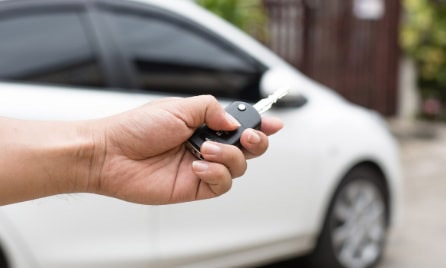- text
-
° This offer is only available for policyholders who have a registered Everyday Rewards Card linked to their eligible active Everyday Insurance policy. This offer is limited to one in-store Woolworths Supermarket transaction up to $500, with a maximum saving of $50 per Everyday Rewards Card, per month, regardless of the number of Woolworths services you use. For full T&Cs click here.
Guide to car insurance for learner drivers in Australia.
Car Insurance | 5 minute read | 8 July 2025

- What is a learner licence in Australia?
- Learner licence conditions in Australia.
- Provisional licence.
- Car insurance excesses and learner drivers.
- Supervising a learner driver and passenger limits.
- Everyday Car Insurance cover options.
- Frequently asked questions about car insurance for learner drivers.
- Why pick Everyday Car Insurance?
- How much is my car worth?
Embarking on your driving journey is an exciting milestone, but before you hit the road, understanding car insurance is crucial. As a learner driver in Australia, you might have questions about whether you need insurance, who it covers, and how to find the right policy.
Let's steer you in the right direction.
What is a learner licence in Australia?
A learner licence is the first step towards obtaining a full driver's licence in Australia. It allows individuals who meet the minimum age requirements (which vary slightly between states and territories, typically 16 or 17 years old) to learn to drive under specific conditions. Obtaining a learner licence usually involves passing a theory test about road rules and regulations.
Learner licence conditions in Australia.
Holding a learner licence comes with several crucial conditions that must be strictly followed:
Supervision: you must always drive under the supervision of a fully licensed driver who meets the requirements in your state or territory (e.g., holding an unrestricted licence for a certain period).
Displaying L plates: clearly visible "L" plates (black on a yellow background) must be displayed on the front and rear exterior of the vehicle.
Zero blood alcohol concentration (BAC): learner drivers must have a BAC of zero while driving.
Mobile phone restrictions: using a mobile phone while driving is strictly prohibited, even when stopped.
Speed limits: learner drivers must adhere to all posted speed limits and specific learner speed limits.
Towing restrictions: rules regarding towing trailers can vary by state or territory, with some jurisdictions restricting or prohibiting it for learner drivers.
Passenger limits: some states and territories may have restrictions on the number of passengers a learner driver can carry.

How many hours do I need to drive on my learners?
To progress from a learner licence to a provisional licence, most Australian states and territories require a logbook of supervised driving hours. The specific number of hours varies per state.
Please note: while this information is current as of July 2025, it's always best to consult your state's relevant authority website for the most up-to-date details.
| State. | Number of hours (as of July 2025). |
|---|---|
| New South Wales. | At least 120 hours, including 20 hours of night driving. |
| Victoria. | At least 120 hours, including 20 hours of night driving. |
| Queensland. | At least 100 hours, including 10 hours of night driving. |
| Western Australia. | At least 50 hours of supervised driving. |
| South Australia. | At least 75 hours, including 15 hours of night driving. |
| Tasmania. | At least 80 hours, with different requirements for those under and over 25. |
| Australian Capital Territory. |
At least 100 hours, including 10 hours of night driving. |
| Northern Territory. |
Requirements vary based on age. |
Provisional licence.
Once the required logbook hours are completed and the driving test is passed, learner drivers typically progress to a provisional licence (usually P1 and then P2). Provisional licences come with their own set of restrictions, which are less stringent than learner licence conditions but still need to be adhered to.
Car insurance excesses and learner drivers.
The excess is the amount you, as the policyholder, are required to pay towards a claim. When a learner driver is involved in an accident, the standard excess of the policy usually applies. Some policies might have specific clauses or higher excess amounts for younger or less experienced drivers. It's important to understand the excess amount and any specific conditions related to learner drivers in your policy.
Excess types.
There are different types of excesses, depending on what your claim relates to, who was driving your car and the type of cover you have chosen.
Everyday Car Insurance excesses.
The table below outlies the different types of Everyday Car Insurance excesses and the situations in which they may apply. This is general information that can be found in the Product Disclosure Statement and may vary based on your policy and circumstances. You can check your excesses on your Certificate of Insurance by logging in your .
This information is current as of July 2025. Please make sure to check the Product Disclosure Statement for the most up to date information.
Supervising a learner driver and passenger limits.
When supervising a learner driver, you must hold a full, unrestricted driver's licence (the specific duration required varies by state or territory). You are responsible for guiding the learner driver and ensuring they adhere to all learner licence conditions.
Passenger limits for learner drivers can vary. Some states might restrict the number of passengers a learner driver can carry, particularly those under a certain age who are not immediate family members. It's crucial to be aware of the specific rules in your state or territory to avoid penalties.
Everyday Car Insurance cover options.
To cater to different needs and budgets, Everyday Car Insurance offers a range of cover options, including:

Comprehensive Car Insurance: our highest level of cover, providing extensive protection for your vehicle and damage you might cause to others.
Learn more about Comprehensive Car Insurance
Drive Less Pay Less: Comprehensive cover tailored to how far you drive. Everyday Drive Less Pay Less is designed specifically for cars that are driven 15,000km per year or less. Plus, eligible drivers could save up to $320 a year.*
Learn more Drive Less Pay Less
Third Party Fire & Theft Car Insurance: covers you for all the benefits of third party property damage along with theft or attempted theft and fire.
Learn more about Third Party Fire & Theft Insurance
Third Party Property Damage Car Insurance: covers you for loss or damaged caused to other people's property that you are legally liable for. It includes liability cover for any person who is legally driving your car with your permission.
Learn more Third Party Property Damage Insurance
For a new driver, especially if the car is relatively new or valuable, Comprehensive Car Insurance can cover a wider range of potential damages and losses. Drive Less Pay Less can be an option if the car is driven not that often, as it can offer some potential savings.* You can compare all Everyday Car Insurance cover options for more information.
Above is a limited summary only. Please read the Car Insurance Product Disclosure Statement for full terms, conditions, limits and exclusions that apply.
Navigating the initial stages of driving can seem complex, but understanding the rules and ensuring adequate car insurance coverage is essential for a safe and legal learning experience. By exploring suitable options for your vehicle, you could ensure the right protection as you gain confidence and experience on the road.
Frequently asked questions about car insurance for learner drivers.
Everyday Insurance policies don't require a separate insurance policy for a learner driver if they are learning on a vehicle where you are the registered owner. However, if they have purchased their own vehicle to learn in, they may require their own policy with themselves listed as a policyholder and the supervising driver as the named driver.
Everyday Insurance policies don't require you to add a learner driver to your policy as a named driver. It's important to check with your insurance company for specific terms and conditions and additional excesses that may apply.
The car insurance excess is the amount you, as the policyholder, are required to pay out-of-pocket when making a claim. If a learner driver operating your vehicle is involved in an accident and a claim is made, the standard excess outlined in your policy will typically apply. Some insurers may have specific or higher excess amounts for younger or less experienced drivers, so it's vital to review your Certificate of Insurance and Product Disclosure Statement to understand all applicable excesses.
As the supervising driver, you are responsible for the learner driver's actions, and your insurance company will assess the claim in the event of an incident. It's important to read the Product Disclosure Statement to check any exclusions and limitation that may apply to learner drivers.
The best type of car insurance for a car driven by a learner driver in Australia depends on your individual needs and the value of the vehicle. While Compulsory Third Party (CTP) insurance is mandatory, you can consider options such as Comprehensive Car Insurance, Drive Less Pay Less, Third Party Property Damage and Third Party Fire & Theft. Compare our cover options for more information.
Car insurance policies can have specific conditions and exclusions related to learner drivers. These often include the requirement that the learner driver must be driving under the direct supervision of a fully licensed driver as per the state or territory laws. Policies may also have age restrictions for learner drivers they cover or stipulate that the supervising driver meets certain criteria (e.g., holding a full licence for a minimum period).
Always carefully read the Product Disclosure Statement (PDS) for full terms, conditions, limits and exclusions that apply.
Why pick Everyday Car Insurance?
Other articles you might like.
> There are some claims for which an excess does not apply. Please check your Product Disclosure Statement for more information.
- text
-
* Savings between $0 to $320 derived from premium comparisons between Everyday Comprehensive car cover option and Drive Less Pay Less option. Calculations based on profiles of existing Everyday Car Insurance customers who drive 15,000km or less annually. Current as at 06 March 2024. Eligibility for Drive Less Pay Less and actual savings is determined by your individual circumstances, including the kilometres selected and other risk factors and underwriting criteria. Minimum premiums may reduce savings. Kilometres can be increased to a limit of 15,000km per period of insurance for an additional premium. In the event of a claim, if the end odometer reading is exceeded, an additional Outside odometer excess will apply.
- text
-
Cover and benefits are subject to eligibility criteria and terms and conditions, including the limits and exclusions of the insurance policy. Any advice provided is general only and may not be right for you. Before you purchase this product you should carefully read the Car Insurance Product Disclosure Statement and consider the Target Market Determination to decide if it is right for you.




